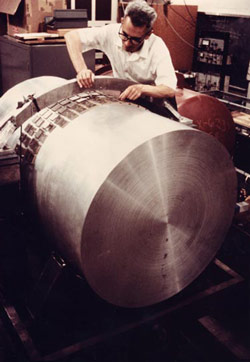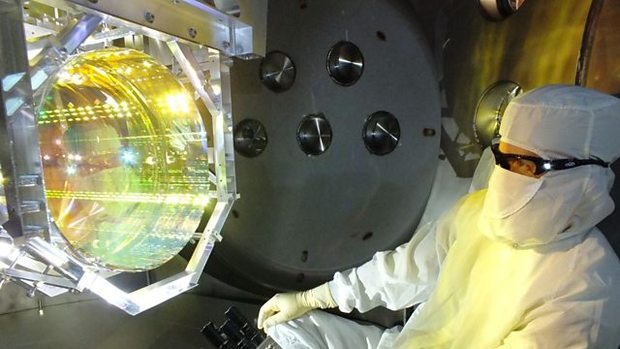Monday, January 11, 2016
astro picture for the day/ Steven Weinberg quote
Image Credit: Cassini Imaging Team, SSI, JPL, ESA, NASA
This is a picture of a Saturn asteroid/moon. It's actually considered a sheppard moon; it makes for one of the major rings of Saturn. Scientists theorize that the structure of the Saturnian rings is much the same, only smaller moons shepparding thinner rings . . . all the way down to the smallest particles of the rings!
"in a way, it's more freer . . . in a way, it's more noble, and more admirable to give point to our lives ourselves rather than to accept it from some external source." - Steven Weinberg
- found some interesting lost technology history - the Photophone
Here's a picture of a Photophone. It was invented by Alexander Graham Bell around 1880. It used modulated light to transmit sound. It was the first wireless communication - back in 1880! There was a mirror that flexed based on sound applied to it. This created modulated light sent to another photophone. So the transmitter was non-electrical; but, the receiver was electrical. The receiver would take in the modulated light and create a modulated electrical signal, which then gets turned into sound.
The Marconi radio started to surpass the Photophone around 1897. The Photophone was still in military service during the 1950s.
For more on the Photophone --> Photophone Wiki , there's also a link of the connections between the photophone and sound recording. Remember the silent films?
- and there's new more or less advanced technology/science to report. By now, maybe you've heard that scientists are excited about the possibility of detecting gravity waves.
Gravity waves have been known to exist since around 1989, when astronomers found that gravitational energy was being sapped by light energy released by two pulsars orbiting one another . . . well, looking up this wiki, Gravitational-wave astronomy , I found that astronomers detected the effects of gravitational waves in 1974, by a Richard Hulse and Joseph Taylor; they were awarded the Nobel prize in 1993! Since then, astronomers/engineers have been building new laser gravity meters . . .
They tried building hugh metal cylinders first;
Joseph Weber and his gravity meter. The wiki on Joseph shows that he managed to get NASA to put a gravity meter on the moon, on the Apollo 17 mission! When you look at this gravity meter, and learn about today's efforts, you just know that he wasn't successful.
- this seems to be a famous picture of one of LIGO's mirrors . . .
I've heard these mirrors bury any astronomical telescope mirror ever constructed in reflectivity. Wish I could find that article again. Physicists also made a major technological breakthrough to make "Advanced LIGO." I've found that the optics have a roughness of .16 nanometers(that's less than the width of an atom). But the squeezed light is really exotic physics/technology
LIGO, and any interferometer gravity meter(this is what's different between Joseph's gravity meter and gravity meters like LIGO) must isolate as much environmental noise as possible - thermal and . . . quantum noise. Quantum physicists found a squeezed light that allows them to reduce quantum noise. The squeezed light comes from making a squeezed vacuum state from which the light comes. LIGO then injects these squeezed light/lasers into the vaccum tubes where they bounce off those super fine mirrors.
Advanced LIGO, as they call it, can detect pulsars and other gravity wave phenomenon out to the distance of the Virgo galaxy cluster. The 21st century should have much the same excitement of 'the newest, most grandest gravity-meter than burries the earlier gravity meters in how far it can see dectect gravity waves' in much the same way we saw telescopes of the 20th century!
Gravity-meters can test inflationary Big Bang cosmology, string theory and look at the physics of black holes, pulsars, supernova like never before!
- right on the heels of Advanced LIGO, is LISA, a space orbiting gravity-meter interferometer that is scheduled to go in orbit in 2017! If we're getting gravity waves detection now, 2017 will be really exciting! Then there's the James Webb space telescope to be placed at one of the lagrangian points.
- here's a pretty good article on the quantum physics and inflationary big bang cosmology science that gravity-meter interferometers will allow us to explore! --> Sounding out the Big Bang
Subscribe to:
Post Comments (Atom)



Ancient enzymes reveal the DNA genesis
ReplyDeletehttp://serious-science.org/ancient-enzymes-reveal-the-dna-genesis-3234
great progress on figuring out the origin of life, through molecular biology.
Seems the gravitational wave detection will be announced as confirmed!
ReplyDeletehttp://www.sciencemag.org/news/2016/02/woohoo-email-stokes-rumor-gravitational-waves-have-been-spotted